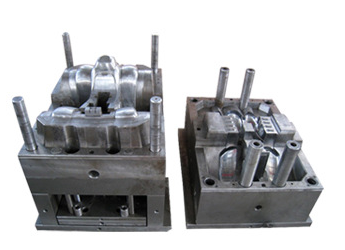A. Difficulty in demolding the gate During the production process of Injection Molding, the gate is prone to getting stuck in the gate sleeve, making it less prone to cracks, resulting in damage to the injection molded parts and seriously affecting production efficiency. The solution is as follows: 1. The operator can use a copper rod to tap the nozzle of the injection Mold to loosen it before demolding;
2. Due to the difficulty in machining the tapered hole of the gate sleeve, standard parts should be used for production as much as possible, or self processing should be carried out to grind the tapered hole to Ra0.4 or above;
3. Set up a gate pulling rod or gate ejection mechanism.
 B. Mold guide pillar damage The structure that plays a guiding role in the mold is the guide pillar, which can ensure that the forming surface of the core and cavity do not come into contact with each other. It should be noted that the guide pillar is prone to damage and deviation during the machining process. The solution is as follows: 1. Guide pillars cannot be used as load-bearing or positioning components; 2. Standardize the manufacturing process of molds and design uniform and reasonable wall thickness parameters. C. Offset of fixed and dynamic molds During the working process of the injection mold, the fixing and moving of the mold may cause deviation, ultimately resulting in rough and damaged surface of the guide pillar. When the situation is severe, the guide pillar will bend or cut, and even the mold cannot be opened. The solution is as follows: 1. Add high-strength positioning keys, such as cylindrical keys, on the parting surface of the mold; 2. Pay attention to the verticality of the guide pillar hole and the parting surface, and ensure the concentricity of the moving and fixed molds during processing to reduce verticality errors; 3. Ensure that the heat treatment hardness of the guide pillar and guide sleeve meets the design requirements.
B. Mold guide pillar damage The structure that plays a guiding role in the mold is the guide pillar, which can ensure that the forming surface of the core and cavity do not come into contact with each other. It should be noted that the guide pillar is prone to damage and deviation during the machining process. The solution is as follows: 1. Guide pillars cannot be used as load-bearing or positioning components; 2. Standardize the manufacturing process of molds and design uniform and reasonable wall thickness parameters. C. Offset of fixed and dynamic molds During the working process of the injection mold, the fixing and moving of the mold may cause deviation, ultimately resulting in rough and damaged surface of the guide pillar. When the situation is severe, the guide pillar will bend or cut, and even the mold cannot be opened. The solution is as follows: 1. Add high-strength positioning keys, such as cylindrical keys, on the parting surface of the mold; 2. Pay attention to the verticality of the guide pillar hole and the parting surface, and ensure the concentricity of the moving and fixed molds during processing to reduce verticality errors; 3. Ensure that the heat treatment hardness of the guide pillar and guide sleeve meets the design requirements.
